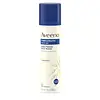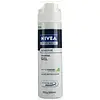What's inside
What's inside
 Key Ingredients
Key Ingredients

 Benefits
Benefits

 Concerns
Concerns

 Ingredients Side-by-side
Ingredients Side-by-side

Water
Skin ConditioningPalmitic Acid
EmollientTriethanolamine
BufferingIsopentane
SolventSorbitol
HumectantStearic Acid
CleansingGlycerin
HumectantSorbitan Stearate
EmulsifyingIsobutane
Sunflower Seed Oil Glyceride
EmollientHydroxyethylcellulose
Emulsion StabilisingPEG-12 Dimethicone
Skin ConditioningAvena Sativa Kernel Flour
AbrasivePhenoxyethanol
PreservativeHydroxypropyl Methylcellulose
Emulsion StabilisingMethylparaben
PreservativePropylparaben
PreservativeEthylparaben
PreservativeBenzaldehyde
MaskingPanthenol
Skin ConditioningTocopheryl Acetate
AntioxidantAloe Barbadensis Leaf Juice
Skin ConditioningAllantoin
Skin ConditioningWater, Palmitic Acid, Triethanolamine, Isopentane, Sorbitol, Stearic Acid, Glycerin, Sorbitan Stearate, Isobutane, Sunflower Seed Oil Glyceride, Hydroxyethylcellulose, PEG-12 Dimethicone, Avena Sativa Kernel Flour, Phenoxyethanol, Hydroxypropyl Methylcellulose, Methylparaben, Propylparaben, Ethylparaben, Benzaldehyde, Panthenol, Tocopheryl Acetate, Aloe Barbadensis Leaf Juice, Allantoin
Water
Skin ConditioningPalmitic Acid
EmollientTriethanolamine
BufferingOleth-20
CleansingIsopentane
SolventSorbitol
HumectantParaffinum Liquidum
EmollientIsobutane
Gossypium Herbaceum Seed Oil
Skin ConditioningTocopheryl Acetate
AntioxidantGlycine Soja Oil
EmollientChamomilla Recutita Flower Extract
MaskingBisabolol
MaskingPEG-90 Glyceryl Isostearate
CleansingHydroxyethylcellulose
Emulsion StabilisingPolyisobutene
Hydroxypropyl Methylcellulose
Emulsion StabilisingPEG-14m
Emulsion StabilisingLaureth-2
CleansingMethylparaben
PreservativePropylparaben
PreservativeBHT
AntioxidantParfum
MaskingWater, Palmitic Acid, Triethanolamine, Oleth-20, Isopentane, Sorbitol, Paraffinum Liquidum, Isobutane, Gossypium Herbaceum Seed Oil, Tocopheryl Acetate, Glycine Soja Oil, Chamomilla Recutita Flower Extract, Bisabolol, PEG-90 Glyceryl Isostearate, Hydroxyethylcellulose, Polyisobutene, Hydroxypropyl Methylcellulose, PEG-14m, Laureth-2, Methylparaben, Propylparaben, BHT, Parfum
 Reviews
Reviews

Alternatives
Ingredients Explained
These ingredients are found in both products.
Ingredients higher up in an ingredient list are typically present in a larger amount.
Hydroxyethylcellulose is used to improve the texture of products. It is created from a chemical reaction involving ethylene oxide and alkali-cellulose. Cellulose is a sugar found in plant cell walls and help give plants structure.
This ingredient helps stabilize products by preventing ingredients from separating. It can also help thicken the texture of a product.
This ingredient can also be found in pill medicines to help our bodies digest other ingredients.
Learn more about HydroxyethylcelluloseThis ingredient is a semi-synthetic polymer created from cellulose. In case you need a refresher, cellulose is the main component of plant cell walls.
Hydroxypropyl Methylcellulose has many uses:
- emulsifier
- create a gel-like texture
- boost foam
We don't have a description for Isobutane yet.
We don't have a description for Isopentane yet.
Methylparaben is a preservative and is a paraben. It is used to prevent the growth of fungus, mold, and other harmful bacteria. Parabens are chemicals used as preservatives in both cosmetics and food.
Methylparaben can be synthetically created. It can also be found naturally in some fruits, such as blueberries.
Oftentimes, Methylparaben is combined with other parabens to help increase the shelf life.
The safety of Methylparaben is currently being studied. While ongoing studies are looking into the safety of parabens, the results have been very mixed. Some studies have not found Methylparaben to be harmful.
Learn more about MethylparabenPalmitic Acid is a fatty acid naturally found in our skin and in many plant and animal sources. In cosmetics, it is usually derived from palm oil. It serves many purposes in skincare, acting as a cleanser, emollient, and emulsifier.
As an emollient, palmitic acid helps soften and smooth the skin by preventing water loss. In cleansers, it helps remove oil and dirt while creating foam.
Its emulsifying properties help stabilize products by keeping water and oil-based ingredients from separating.
This may not be suitable for fungal acne-prone skin, as fatty acids like this can sometimes trigger breakouts in sensitive individuals.
Learn more about Palmitic AcidPropylparaben is a preservative and is a paraben with antifungal and antimicrobial properties.
This ingredient can be naturally found in plants and insects, but most of it is synthetically manufactured for human use. In cosmetics, it is usually created by reacting para-aminobenzoic acid and propanol (an alcohol).
You can usually find this ingredient in water-based products.
Parabens have come under controversy due to the claim they are hormone disruptors. Studies show conflicting results. We recommend speaking with a professional if you have any concerns.
Propylparaben is commonly found in food, medicine, and cosmetics.
Learn more about PropylparabenSorbitol is a sugar alcohol. It is a hydrating and moisturizing agent created from the reduction process of glucose.
Most sorbitol is usually made from potato starch. It is also found in fruits such as apples and pears.
As a humectant, Sorbitol helps draw water to the skin. This helps keep the skin hydrated. Sorbitol also helps create a thicker texture in products. You might find sorbitol in your toothpaste and other gels.
It is a non-irritating ingredient that is great for those with dry skin.
Sorbitol is a prebiotic. It helps promote the growth of healthy bacteria on your skin. The bacteria on your skin form a microbiome. This microbiome helps protect your skin from infection and harmful bacteria.
Learn more about SorbitolTocopheryl Acetate is AKA Vitamin E. It is an antioxidant and protects your skin from free radicals. Free radicals damage the skin by breaking down collagen.
One study found using Tocopheryl Acetate with Vitamin C decreased the number of sunburned cells.
Tocopheryl Acetate is commonly found in both skincare and dietary supplements.
Learn more about Tocopheryl AcetateTriethanolamine is an emulsifier and pH adjuster. It is created using ethylene oxide and ammonia. This gives Triethanolamine a nitrogen core and a similar scent to ammonia.
As an emulsifier, it prevents ingredients from separating and enhances texture by adding volume to a product.
PH adjusters are common in cosmetic products. The pH of a product can affect the effectiveness of other ingredients. A product with a high pH may also irritate the skin.
Learn more about TriethanolamineWater. It's the most common cosmetic ingredient of all. You'll usually see it at the top of ingredient lists, meaning that it makes up the largest part of the product.
So why is it so popular? Water most often acts as a solvent - this means that it helps dissolve other ingredients into the formulation.
You'll also recognize water as that liquid we all need to stay alive. If you see this, drink a glass of water. Stay hydrated!
Learn more about Water